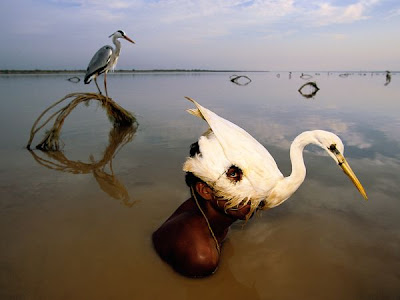Colorado River
The Colorado River
is one of the most used and contested waterways on Earth. It provides
water for 30 million people, and has many dams and diversions along its
1,450 miles (2,333 kilometers).
Because it is
so heavily tapped for agriculture, industry, and municipal uses along
its course, the Colorado River rarely reaches its delta and the Gulf of
California. About one-tenth of the river's former flow now makes it to
Mexico, but most of that is used for farming and cities south of the
border.
Indus River
Peering
from a decoy, a hunter lifts his head above the water of the Indus
River. The Indus is the primary source of freshwater for most of
Pakistan, a fast-growing nation of more than 170 million people.
Waters
from the Indus are drawn for household and industrial use, and support
about 90 percent of the agriculture in the arid country. The Indus is
one of the great rivers of the world, but it is now so exploited that it
no longer flows into the ocean at the Port of Karachi.
Instead, in the words of New York Times
writer Steven Solomon, the Indus is "dribbling to a meager end . . .
Its once-fertile delta of rice paddies and fisheries has shriveled up."
The lower Indus had been a lush ecosystem, supporting artisanal fishers
and providing habitat to diverse species, including the critically
endangered Indus River dolphin.
Choked off from
its water supply, Karachi is plagued by increasingly brazen water
thieves and riots over scarcity. Many in the water-stressed delta blame
wealthy landowners upstream for taking water out of the river. As National Geographic News recently reported,
tensions have been running high with neighboring India, which is home
to the glaciers that feed the river, and which is planning more
large-scale diversions.
Rio Grande River
One
of the largest rivers in North America, the 1,885-mile
(3,033-kilometer) Rio Grande runs from southwestern Colorado to the Gulf
of Mexico. It defines much of the border between Texas and Mexico. But
the once grande river is looking more poco these days, thanks to heavy use on both sides of the border.
Less than a fifth of the Rio Grande's historical flow now reaches the Gulf. For a few years in the early 2000s, the river failed to reach the coast entirely. All that separated the United States from Mexico was a beach of dirty sand and an orange nylon fence.
Here, the river defines the international border across the Adams Ranch near Big Bend National Park.
Read more @ NationalGeographic.com
Read more @ NationalGeographic.com



No comments:
Post a Comment